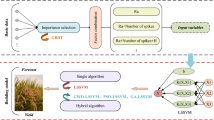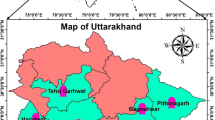Abstract
A coupled particle swarm optimization (PSO) least squares support vector machine (LSSVM) model based on the Hilbert–Huang transform (HHT) was established to provide accurate estimations of reference crop evapotranspiration \((\hbox {ET}_{0})\) in cold and arid areas that lack the required meteorological data. Daily data (2000–2009) from the Hetian Xinjiang meteorological station (China) were used for training and double-day data used for validation. The accuracy of the method was compared with two machine models, the conventional PSO-LSSVM model and a generalized regression neural network, and three empirical methods, the Hargreaves, FAO-24 Penman, and Priestley–Taylor models. Under the condition of the same parameters of meteorological data, the accuracies of the machine models were found better than the empirical models, and the precision of the PSO-LSSVM coupled algorithm based on the HHT was the highest. The relative importance of the prediction elements was Rs > Tmax > Tmin > RH > Wn. When the deletion combination was Tmax/Tmin/RH/Wn, Tmax/RH/Wn, Tmin/Wn, and Wn, the mean square error was 0.407, 0.185, 0.149, 0.135, respectively, which shows this method is adequate for estimating \(\hbox {ET}_{0}\) in data-sparse areas.


Similar content being viewed by others
References
Allen, R.G., Walter, L.A., Elliott, R., et al.: Issues, requirements and challenges in selecting and specifying a standardized ET equation. In: Evans, R.G., Benham, B.L., Trooien, T.P. (ed.), Proceedings of the National Irrigation Symposium, ASAE, Nov, 14–16, 2000, Phoenix, Az, pp. 201–208 (2000)
Gorka, L., Amaia, O.B., Jose, J.L.: Comparison of artificial neural network models and empirical and semi-empirical equations for daily reference evapotranspiration estimation in the Basque Country (Northern Spain). Agric. Water Manag. 95(5), 553–565 (2008)
Hou, Z.Q., Yang, P.L., Su, Y.P., Ren, S.M.: Simulation of \(\text{ ET }_{0}\) based on LS-SVM method. Shuili Xuebao 42(6), 743–749 (2011)
Kumar, M., Raghuwanshi, N.S., Siongh, R.: Estimating evapotranspiration using artificial neural network. J. Irrig. Drain. Eng. 128(4), 224–233 (2002)
Khoob, A.R.: Comparative study of Hargreaves’s and artificialneural network‘s methodologies in estimating reference evapotranspiration in a semiarid environment. Irrig. Sci. 26(3), 253–259 (2008)
Huang, N.E., Shen, Z., Long, S.R., et al.: The empirical mode decomposition and the Hilbert spectrum for non-linear and non-stationary time series analysis. Proc. R. Soc. Lond. A: Math. Phys. Eng. Sci. 454, 903–995 (1998)
Zhao, C.X.: The Research of Time-Frequency Analysis Method Based on Hilbert-Huang Transform, pp. 11–13. China University of Petroleum, Beijing (2011)
Kumar, M., Bandyopadhyay, A., Raghuwanshi, N.S., et al.: Comparative study of conventional and artificial neural network-based \(\text{ ET }_{0}\) estimation models. Irrig. Sci. 26(6), 531–545 (2008)
Chi, D.C., Li, S.Y., Yu, M., et al.: Predicting reference evaportranspiration based on LS-SVM. J. Shenyang Agric. Univ. 40(2), 206–209 (2009)
Kennedy, J., Eberhart, R.C.: Particle swarm optimization. In: Proceedings of IEEE International Conference on Neural Networks, pp. 1942–1948 (1995)
Ren, J.T.: Simultaneous feature selection and SVM parameters optimization algorithm based on binary PSO. Comput. Sci. 34(6), 179–182 (2007)
Li, Y.K., Tian, Y.J., Ouyang, Z.Y., et al.: Analysis of soil erosion characteristics in small watersheds with particle swarm optimization, support vector machine, and artificial neuronal networks. Environ. Earth Sci. 60(7), 1559–1568 (2009)
Yao, Q.Z., Cai, J.: Feature selection and LS–SVM parameters optimization algorithm based on PSO. Comput. Eng. Appl. 46(1), 134–136 (2010)
Wang, X.H., Guo, M.H., Xu, Z.M.: Comparison of estimating ET\(_{0 }\)in arid-area of Northwest China by Hargreaves and Penman–Monteith equation. Trans. CSAE 22(10), 21–25 (2006)
Sun, Q.Y., Tong, L., Zhang, B.Z., Tang, B.: Comparison of methods for calculating reference crop evapotranspiration in Haihe River basin of China. Trans. CSAE 26(11), 68–72 (2010)
Zhao, X., Li, Y., Liu, J.M.: Prediction of reference crop evapotranspiration with grey model in Xinjiang region. Trans. CSAE 25(10), 50–56 (2009)
Shi, X.N., Wang, Q.J., Wang, X., et al.: Adaptability of different reference evapo-transpiration estimation methods in XinJiang region. Trans. CSAE 22(6), 19–23 (2006)
Acknowledgements
This work was supported by Science and Technology Promotion Plan of PRC Ministry of Water Resources (No. TG1510).
Author information
Authors and Affiliations
Corresponding author
Rights and permissions
About this article
Cite this article
Wang, P., Liu, C. & Li, Y. Estimation method for \(\hbox {ET}_{0}\) with PSO-LSSVM based on the HHT in cold and arid data-sparse area. Cluster Comput 22 (Suppl 4), 8207–8216 (2019). https://doi.org/10.1007/s10586-018-1726-x
Received:
Revised:
Accepted:
Published:
Issue Date:
DOI: https://doi.org/10.1007/s10586-018-1726-x




